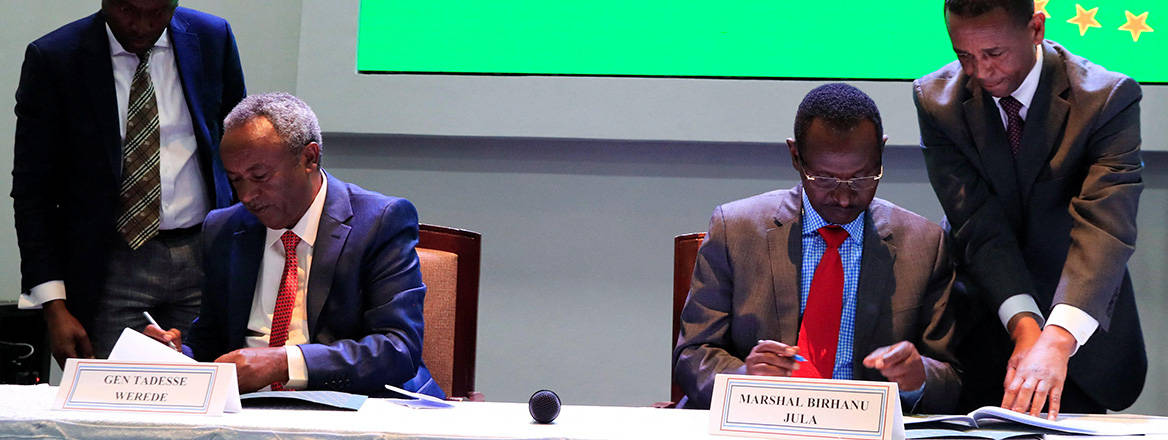Peace Prospects in Ethiopia: A ‘New Dawn’ or Kicking the Can Down the Road?
The settlement agreed by the parties to Ethiopia’s conflict offers hope for a lasting peace. But further measures are still needed to deter future violence and instability.
Following the end of the eight days of South Africa-hosted peace talks between Ethiopia’s Federal Government and the Tigray People’s Liberation Front (TPLF), former Nigerian president and chair of the African Union (AU) High Level mediation panel, Olusegun Obasanjo, described the outcome as a ‘new dawn’.
This ‘new dawn’, and the direction laid out for Ethiopia, must earn the ongoing support of the people, the parties and international actors. It must also be reinforced by other important reform initiatives in order to address clear sources of instability in the country. Failing on these measures of support opens a risk that the recently brokered peace agreement will simply be an instance of kicking the can down the road.
There is no doubt that the Ethiopian people support peace. Many regard the TPLF-initiated war, which began with an unexpected and lethal attack by TPLF forces on federal military bases, to have been unnecessarily long and tragic. In ballots cast in both June and September 2021 – and despite some irregularities and the non-participation of the Tigray regional state – a high voter turnout, even for western standards, in what was regarded by international observers as the country’s first ‘peaceful and credible’ federal election, was observed. The incomplete electorate notwithstanding, the strong support for Prime Minister Abiy Ahmed’s Prosperity Party symbolised the Ethiopian people’s desire to pursue the broader democratic path which had been promised by the Abiy-led government.
The government has not yet made significant progress with reforms that are needed to eliminate the divisive ethnic-based federalist constitution, unconstitutional regional-based security arrangements, and some contested federal and regional borders in different parts of the country. Doing so without having Tigray regional state representation in parliament (in 2020, the TPLF called on all TPLF politicians and civil servants to leave the Abiy-led Prosperity Party and return to Tigray’s regional capital, Mekelle) would arguably have only generated further tensions and perhaps necessitated a re-run of these discussions once a sustained peace in northern Ethiopia had been achieved.
To have a stable foundation in place for peace to move forward, the government must now push these reforms forward in earnest. It must do this while building a plural democratic governance model in Tigray; rebuilding the conflict-affected regional states of Tigray, Amhara and Afar, while expediting the disarmament of the Tigray rebel force; and accelerating a meaningful truth and reconciliation process to support healing and the unification of the country – a process which many Tigrayans support.
There is a risk that rebel commanders who regard the outcome of the peace talks as a ‘raw deal’ may well continue the fighting and pursue their own interests
The outcome of the peace talks reflected what could be described as a ‘face-saving surrender’ of the TPLF – face-saving in the context of the government of Ethiopia agreeing to propose a lifting of the Ethiopian parliament’s terrorist designation of the TPLF, and including some TPLF military commanders in the initial planning discussions concerning disarmament and the handover of federal military hardware, which had been taken by the rebel force following the attack on the northern command. The agreement appeared also to reflect a hardened commitment among the African leaders facilitating the talks – and across the African continent more generally – to ‘silence the guns’ and prevent unconstitutional violent coup d’états, the latter of which emerged as a priority theme at the October 2022 Tana Forum on Security in Africa. Lastly, that the TPLF walked away from the peace talks with little else exposed the low capacity and leverage that the insurgent group had left – and also how so much of this capacity and leverage had been depicted differently on social media.
The TPLF’s signing of the peace agreement, and the subsequent participation of some of its military commanders in the 7 November Nairobi-based meeting on the implementation of the Cessation of Hostilities Agreement, signals a desire to give peace a chance. But as observed in peace processes elsewhere in the world, some splintering of former combatants – some of whom may not support the outcomes of the AU-brokered peace agreement – is inevitable. There is a risk that rebel commanders who regard the outcome of the Pretoria-based talks as a ‘raw deal’ may well continue the fighting and pursue their own interests. The same may apply to other groups who have been operating outside of Tigray, but who have had interests in the conflict. It is for these reasons that the 10-person monitoring and verification force proposed in the peace agreement will be insufficient to deter spoilers – who may feel deprived of any peace dividend – from further violence.
The importance of a monitoring and verifying process cannot, in the face of a consistently divisive and disruptive information war, be underestimated. The text of the peace agreement proposes a monitoring and verification provision resembling the model used in the Northern Ireland peace process, which featured a small decommissioning team comprising three international leaders and two religious leaders from the province. This model, headed by a former Canadian Chief of Defence Staff, had him report specifically on progress surrounding the decommissioning of weapons, without publicly disclosing much detail but providing the population with assurances that decommissioning was progressing according to plan.
It is important that an independently verified disarmament process in Tigray – and details concerning the situation more broadly – are shared in a public, detailed and regular manner in order to narrow the space for unverified information to circulate, and for unverified information to be used for political purposes, particularly across the wider global community.
Key to independent verification and monitoring are forensic investigations concerning mass graves, Ethiopian National Defense Force and Eritrean Defense Force (EDF) uniforms – which were allegedly produced for the purposes of the conflict – and accountability surrounding all uniformed soldiers killed, surviving and missing in action following the 3 and 4 November 2020 attacks. Also important is accountability surrounding the alleged atrocities and human rights violations (across all conflict-affected regions including Oromia) and the whereabouts of those reportedly released from prisons across the Tigray region during the conflict, as well as the many refugees who dispersed from Tigray-based refugee camps. The resurrection of the federally supported food safety net programmes, not only in rural areas of Tigray but also in the arid regions of northern Amhara and Afar, is also essential for sustained food security. These programmes stand to benefit greatly, if realised, from the federal government’s plans to use irrigation systems to generate three – as opposed to one – annual harvests.
The commitment and resources required to support the monumental reform exercise envisioned in the text of the peace agreement should not be underestimated
The question of a presence of Eritrean forces in Tigray is an ongoing concern for international actors. The lack of independent reporting from Eritrea–Tigray border areas; allegations of both cross-border activity and bogus EDF uniforms in circulation in Tigray; and the lack of resolve over the international border around the town of Badme could turn this issue into a very thorny ongoing challenge. Although the Ethiopian prime minister stated in parliament that the peace process in Tigray would not concern contested land issues, it is important to establish whether, for the purposes of the peace process, the 2002 Eritrea–Ethiopia Boundary Commission’s decisions on the demarcation of the shared Ethiopia–Eritrea border – particularly around the town of Badme, where both national armed forces have maintained a historical military presence – will hold. This was one of the agreed items underpinning Ethiopia’s 2018 peace dividend with Eritrea – to recognise the border arrangements agreed as part of the Algiers Agreement – for which the Ethiopian prime minister was awarded a Nobel Peace Prize. While Ethiopia’s pre-conflict circumstances in Tigray never provided a conducive environment for a localised and ceremonial handover of this land, a working definition of what border will now be recognised for the purposes of the peace process is important. Failure to achieve this will undermine monitoring and verification efforts in these areas and provide an ongoing rationale for some to continuously accuse Eritrea of having a presence in Tigray.
There is no doubt that a fuller discussion must embrace contested frontiers elsewhere in the country, including Welkait-T’egede, Raya and other ill-defined or ambiguous land issues. This discussion must run parallel to other necessary security and economic reforms. A more accountable regional security architecture with a primary chain of command to the prime minister and a secondary one to the regional presidents, which does not include a special elite paramilitary capability falling under regional authorities, and which empowers regional police forces – which formerly fell through the cracks of both federal military and regional militia structures – should be prioritised. Lastly, momentum behind capital market reforms – including the proposed launch of the Ethiopia stock exchange – could accelerate economic growth and opportunities in a more publicly accountable private sector and support peace dividends. To enable this acceleration, efforts to promote the knowledge and competencies required to support plural and democratic politics are also important.
The commitment and resources required to support the monumental reform exercise envisioned in the text of the peace agreement should not be underestimated; nor should the requirement to end a largely disinformation-based war, the impact of which has been colossal. As the virtualisation of this conflict has only served to globalise an insurgency, a multi-stakeholder commitment to peace – one which includes the sustained support and commitment of the Ethiopian people, the political parties, Ethiopian diaspora groups and international actors – is required. Among this support, a robust and accountable AU monitoring and verification capability and access for independent reporting should be prioritised.
The views expressed in this Commentary are the authors’, and do not represent those of RUSI or any other institution.
Have an idea for a Commentary you’d like to write for us? Send a short pitch to commentaries@rusi.org and we’ll get back to you if it fits into our research interests. Full guidelines for contributors can be found here.
WRITTEN BY
Professor Ann M. Fitz-Gerald
RUSI Senior Associate Fellow, Cyber and Tech
The Hon. Hugh Segal OC OOnt CD
- Jim McLeanMedia Relations Manager+44 (0)7917 373 069JimMc@rusi.org



